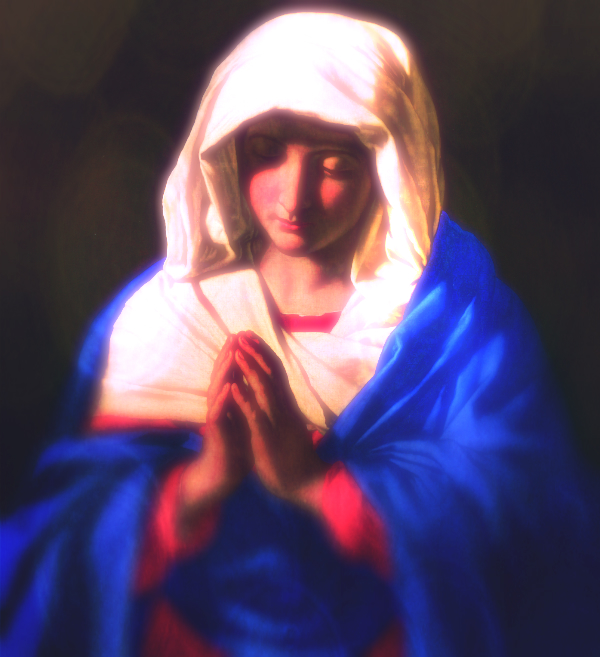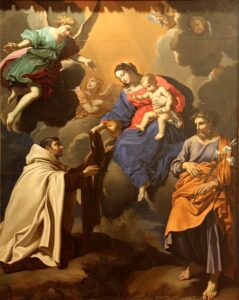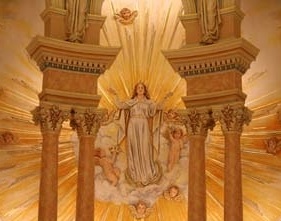
Celebrating the Assumption of Our Lady
“Just as the Mother of Jesus, glorified in body and soul in heaven, is the image and beginning of the Church as it is to be perfected in the world to come, so too does she shine forth on earth, until the day of the Lord shall come (304), as a sign of sure hope and solace to the people of God during its sojourn on earth.” – Vatican II, Dogmatic Constitution on the Church, 68
As a child, I learned about Mary – her pristine soul, her perfect meekness and humility, her incomparable beauty. I felt I was the opposite of her – clearly born with Original Sin, a feisty and spirited soul, and, well, not so physically attractive. I had glasses and braces, thick, bushy hair, and a cackling belly laugh. Not so graceful, is it?
Still, I prayed to Mary. She was a distant figure at first, certainly not the intimate maternal heart of mercy I attribute to her today. I memorized the Hail Mary, later the Memorare and Hail, Holy Queen. The rosary became a comfort to me, though I never delved into why.
 The Dogma of the Assumption of Mary into Heaven body and soul was never a question for me – not until, that is, I entered high school. It was there I realized I did not have answers to those who were skeptical of my Catholic upbringing.
The Dogma of the Assumption of Mary into Heaven body and soul was never a question for me – not until, that is, I entered high school. It was there I realized I did not have answers to those who were skeptical of my Catholic upbringing.
As an adult, I wondered what the difference was between the Assumption of Mary and the Ascension of Jesus. Both went to Heaven, body and soul. Obviously, Jesus is God, and Mary is not, but what else differentiated these miraculous events, and why did we celebrate them? I’ll explain more in the following paragraphs.
To begin, Mary’s assumption was a passive event; she was lifted up to Heaven by God. This is to signify that, though sinless, she was still a creature of God and not God Himself. By contrast, Jesus was assumed into Heaven, meaning that He actively returned to the Father of His own accord – to demonstrate His divinity and royal priesthood.
Pope Emeritus Benedict XVI has written beautifully about the Assumption of Mary. Here are some of my favorite quotes:
“Mary is ‘blessed’ because – totally, in body and soul and for ever – she became the Lord’s dwelling place. If this is true, Mary does not merely invite our admiration and veneration, but she guides us, shows us the way of life, shows us how we can become blessed, how to find the path of happiness.”
Her Assumption into Heaven reminds us that she is our guide and mentor to our eternal destination. And because she was also born human, she is personally invested in helping us attain it.
“By looking at Mary’s Assumption into Heaven we understand better that even though our daily life may be marked by trials and difficulties, it flows like a river to the divine ocean, to the fullness of joy and peace. We understand that our death is not the end but rather the entrance into life that knows no death. Our setting on the horizon of this world is our rising at the dawn of the new world, the dawn of the eternal day.”
We will not enjoy the gift of Divine Assumption into Heaven. But we do have the hope, through Mary’s miraculous Assumption, that our sufferings will one day end. The life we live on earth is but a mirage compared to the time we will spend infinitely facing God. That is our hope. The Feast of the Assumption reminds us of that.
The Assumption reminds us that Mary’s life, like that of every Christian, is a journey of following, following Jesus, a journey that has a very precise destination, a future already marked out: the definitive victory over sin and death and full communion with God…
This is the reality of every Christian – we are a pilgrim people. Maybe that’s why, thirty years after I first learned about Mary in my first grade religion class, I could finally talk to her as I spoke to my earthly mother – freely, honestly, openly. She longs to travel with us in this life and lead us to life hereafter.







 Most people choose a hymn like “Hail Mary, Gentle Woman” for the presentation of a flower to Our Lady during their Nuptial Mass. Ben and I chose “Holy Is His Name,” which is a variation of the Magnificat prayer sung to a Celtic tune. There has always been something cherished, beloved about imagining Mary’s humility and depth of pondering in this prayer.
Most people choose a hymn like “Hail Mary, Gentle Woman” for the presentation of a flower to Our Lady during their Nuptial Mass. Ben and I chose “Holy Is His Name,” which is a variation of the Magnificat prayer sung to a Celtic tune. There has always been something cherished, beloved about imagining Mary’s humility and depth of pondering in this prayer.
 moment by their blasphemies and ingratitude. You, at least, strive to console me, and so I announce: I promise to assist at the hour of death with the grace necessary for salvation all those who, with the intention of making reparation to me, will, on the first Saturday of five consecutive months, go to confession, receive Holy Communion, say five decades of the beads, and keep me company for fifteen minutes while meditating on the fifteen mysteries of the Rosary.”
moment by their blasphemies and ingratitude. You, at least, strive to console me, and so I announce: I promise to assist at the hour of death with the grace necessary for salvation all those who, with the intention of making reparation to me, will, on the first Saturday of five consecutive months, go to confession, receive Holy Communion, say five decades of the beads, and keep me company for fifteen minutes while meditating on the fifteen mysteries of the Rosary.”